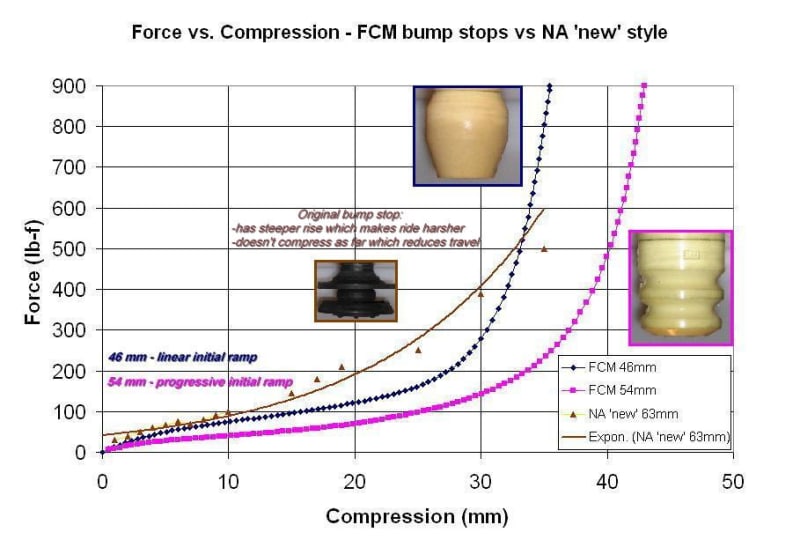Following a couple of threads here on sta-bars, I understand the need to increase roll resistance (without uncomfortably high ride rate) to meet passenger comfort expectations and prevent excessive camber gain, which would reduce tire grip. In aero racing, aero devices require ride height and body attitude control at the expense of any other considerations.
Rather than allowing the outside suspension to compress and the inside suspension to droop, sta-bars compress the inside suspension, keeping passengers and tires comfortably level.
However, the load on the outside tire unloads the inside tire through the sta-bar. This increased load transfer reduces total grip available on that axle, and thus the sta-bar can “provide a convenient means of track-side chassis tuning (1999-01-2257). However, I’ve read “Generally, you want ~2/3 of your roll stiffness from springs and the remaining ~1/3 from bars for a performance oriented set-up.”
Such a large proportion of roll stiffness from sta-bars would appear to significantly increase load transfer and thus sacrifice quite a bit of ultimate grip, and a large sta-bar presents a packaging challenge, and weight and serviceability penalties. The cumulative stiffness rate also undesirably applies to one-wheel bumps rather than just cornering.
Wouldn’t it be better to achieve gross under/oversteer with tire selection? A narrower and thus lighter and cheaper tire (and thus wheel) could achieve similar restriction of lateral grip at that axle while still providing sufficient longitudinal grip for braking (my 1g braking front load is 20% lower than 1g lateral).
For suspension control (and specifically camber gain, in this question), it appears that integrated spring aids (first bump stops and now bump springs) are standard setup in stock car racing. In fact, stock car suspensions now seem to be set up to ride on the bump stops for aero and suspension control. Why not design to touch down on soft (say 80-100lbf/in) progressive bump stops to prevent excessive camber change? The total effective spring rate required to do so should be equivalent whether from springs alone, or springs and sta-bar, or springs and bump stop.
But using the bump stops for camber control would give the mechanical grip advantage of soft springs without sacrifices of lateral grip and suspension independence, and without the packaging challenge and weight and serviceability penalties. Are sta-bars just a vestige of OEM passenger applications, perpetuated by “tuners”?
I am curious to hear your thoughts.
Rather than allowing the outside suspension to compress and the inside suspension to droop, sta-bars compress the inside suspension, keeping passengers and tires comfortably level.
However, the load on the outside tire unloads the inside tire through the sta-bar. This increased load transfer reduces total grip available on that axle, and thus the sta-bar can “provide a convenient means of track-side chassis tuning (1999-01-2257). However, I’ve read “Generally, you want ~2/3 of your roll stiffness from springs and the remaining ~1/3 from bars for a performance oriented set-up.”
Such a large proportion of roll stiffness from sta-bars would appear to significantly increase load transfer and thus sacrifice quite a bit of ultimate grip, and a large sta-bar presents a packaging challenge, and weight and serviceability penalties. The cumulative stiffness rate also undesirably applies to one-wheel bumps rather than just cornering.
Wouldn’t it be better to achieve gross under/oversteer with tire selection? A narrower and thus lighter and cheaper tire (and thus wheel) could achieve similar restriction of lateral grip at that axle while still providing sufficient longitudinal grip for braking (my 1g braking front load is 20% lower than 1g lateral).
For suspension control (and specifically camber gain, in this question), it appears that integrated spring aids (first bump stops and now bump springs) are standard setup in stock car racing. In fact, stock car suspensions now seem to be set up to ride on the bump stops for aero and suspension control. Why not design to touch down on soft (say 80-100lbf/in) progressive bump stops to prevent excessive camber change? The total effective spring rate required to do so should be equivalent whether from springs alone, or springs and sta-bar, or springs and bump stop.
But using the bump stops for camber control would give the mechanical grip advantage of soft springs without sacrifices of lateral grip and suspension independence, and without the packaging challenge and weight and serviceability penalties. Are sta-bars just a vestige of OEM passenger applications, perpetuated by “tuners”?
I am curious to hear your thoughts.

